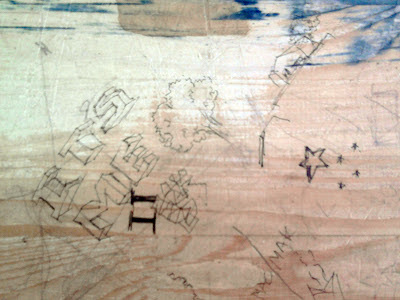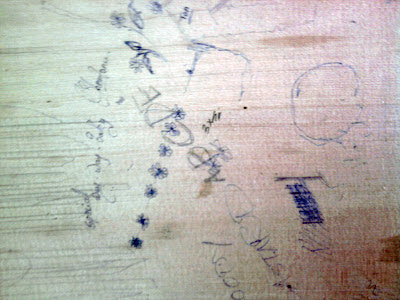As I begin to depart briefly from the academia here in India, I feel it's important that I summarize the last four years I spent in teaching. This post is essentially a crib post, since very little of what I actually tried to do was realized. Perhaps this post will be constructed in parts over the next two months, eventually trying to crystallize my teaching method and theoretical stance on architectural subjects. How has it developed and how has it changed. I want to be able to make these set of writings as a springing point for my post graduate study. Hence, I feel intensive reflection and discussion will help. At the same time, I want to locate problem areas (within the scope of my academic space - Academy of Architecture), extrapolating it to certain generic patterns of academic environment that has emerged recently.
It may be difficult to be chronological, since these are glimpses of memory, flashes of instances and triggers of thoughts. I am only trying to stitch a narrative. A lot of work and commentary can be found on the posts tagged 'academics' on this blog. I will try to remain consistent with the thoughts that I have raised earlier. However, I may be wavering, since this post is intended as a reflection, and I assume to have collected some wisdom over the last four years in the area of teaching and pedagogy.
I joined Academy of Architecture on the invitation of Mr. Arvind Adarkar, being recommended by Dushyant (Desai). Dushyant was fascinated with my thesis and thought I would be an interesting addition to his team. I was always interested in coming back to college and interacting with my peers. I was interested in discussion of ideas, debating architectural issues and thinking design. I quickly joined in, along with my classmate Dhaval. In the league of Dushyant, our team initiated projects that were conceptually difficult for first year students to undertake. We experimented with different forms of media and representation. It was difficult to keep pace with Dushyant's philosophical discourses. We (the faculty) debated, discussed and there were lots of intense sessions. It was enjoyable.
Dushyant left by the next year and I tried to immerse myself more with the school. I started taking Graphics lectures for first year students. This was the time when thoughts of bringing serious changes came into my mind. Apart from learning technical drawing skills, I didnot understand what 'graphical' did graphics teach. Occassionally I would ask students to go beyond what was asked for and excite them by giving small trivia in class. Those who would finish first would get an additional trick question. Some students enjoyed. But this soon died out since other faculties weren't interested and their ideas of graphics or graphical composition were ages old. In architectural design, I took this time to unwind myself from the Dushyant hangover. I had found myself immensely stuck in his philosophical methodology, which for me, didnot work for several reasons. It was too philosophical for me (as well as the students) to be translated into a design project. At many instances, it was forced and was the faculty's project more than the students'.
Unwinding partly became possible because of 2 primary reasons: my research fellowship and working with Rupali (Gupte). Basically teaching at Kamla Raheja introduced me to working with a METHOD. In the process of my fellowship research, the mechanics of a "METHOD" clarified further. I realised that methods make the design output predictable to a large extent. Thus students can be pushed to experimenting with different methodologies to bring out newer concepts. With Rupali, I learnt how representation affects our understanding of space and how it is important to perfect representation before spaces are intervened in. Kamla Raheja's methodical approaches made me challenge Dushyant's philosophical ones. I realized how theories translate into space. Interacting with Rohan (Shivkumar) and all my colleagues at KRVIA helped me understand the relevance of theory. The idea of formation of methodology occurred through the pursuit of my Research fellowship. Here, I learnt to develop a 'research framework' for analysis, method of argument and structuring a paper. Thus, the fellowship enabled me to become more independent and think on my own.
Unfortunately, I was not able to continue at KRVIA due to logistical reasons. At the same time, there also seemed no options that KRVIA could make space for me. This was the time when I expected I would go for my masters. However, luck didnot favour and all projects I was involved in were stalled. It was economic recession and I was pressed to make a decision between practice and academia. The decision was hard since I would have ideally liked to teach at KRVIA - I knew I could learn so much more by being in that environment. At the same time, it wasn't logistically feasible unless I took up a permanent job. A sudden opportunity broke open at Academy. I was invited again, this time by Adarkar Sir to take up a permanent position for the new wing of AOA that was entering in its second year. They required permanent staff and I took it up. Frankly, it wasn't a job I readily took up, since it wasnt my first choice. I knew the visionless state of the institution and I knew I would have to deal with much difficult people. But I don't think there would have been any better option available to me at that point of time. I was too egoist to discuss these things with my colleagues at KRVIA. And I also realised that they were looking for a more permanent person who could stick along with them, in case they were to open to me a full time post. I knew I had to go for my masters.
I think that was a difficult phase. But I saw an opportunity to set the tone for the new wing of AOA based on rigorous dialogue, thinking and departure from the old programs we did in design. In this journey, my closest companion was Atul Mhatre. Atul had just flown down from London, after finishing his masters in Architectural Association. Atul too was in line with what I learnt as a 'methodical approach' at KRVIA. This boosted the way in which we designed programs. We understood each others' ideas, and we being classmates, understood each others' strengths and weaknesses. Thus we worked as quite an efficient team. Atul too was interested in theory and AA had prepared with with a lot of reading. We occasionally would share a lot of ideas and churned out lots of thoughts for events, programs and seminars for AOA. However, Atul was too busy setting up his own architectural practice during this period. It only revealed to me gradually over the year that probably, he just used the academic space as a buffer to bridge his comeback from AA to setting up his practice here. This full time job, which demanded him to spend only half his day in the school was used as an opportunity for him to dedicate a time to his fledgling practice.
Atul's contribution in the administrative affairs was minimal. He did not carry forward an idea he would initiate to its logical execution. He was extremely sophisticated and did not let us know whether he was really interested in pursuing a career in academics. Although he called himself an academician, he seldom contributed to the discourse of architecture in the form of writing or presenting his work. Although, he was extremely informed, too refined and too teacher like. But Atul also oriented me to tackling students issues in a more systematic manner. For the first time, on learning from Atul's experiences at AA, we conducted a Mid term Review. This review was meant to make students conscious of their progress taking into consideration their performance in academics, addressing their strengths and weaknesses and giving them a clear direction to improve their performance. We followed up this method and it seemed to be quite beneficial. Atul made me realize the importance of written communication, like Charles Correa would also suggest subsequently. He taught me how to deal with students' personal issues professionally. I was quite an emotional guy without the intervention of Atul. I shall always respect him for that.
We prepared an ambitious manifesto for AOA and presented it to the Principal - Mr. Arvind Adarkar. It shall be the right time to turn to Part II of this post and talk about the next important person in my academic life - Prof. Adarkar.















